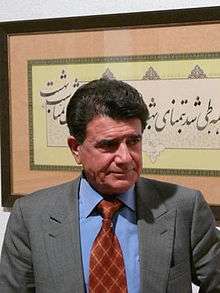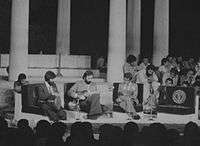Mohammad-Reza Shajarian
Mohammad-Reza Shajarian (Persian: محمدرضا شجريان; Persian pronunciation: [mohæmːæd ɾeˈzɒː ʃædʒæɾiˈɒːn]) (23 September 1940) is an Iranian classical singer, composer and Ostad (master) of Persian traditional music.[2][3][4] He has been called "Iran's greatest living maestro of Persian classical music."[5] Shajarian is also known for his skills in Persian calligraphy, and humanitarian activities.
Mohammad-Reza Shajarian | |
|---|---|
 | |
| Born | Mohammad-Reza Shajarian September 23, 1940 Mashhad, Iran |
| Alma mater | Shah Reza School |
| Occupation | Singer-songwriter Composer Calligrapher |
| Spouse(s) | Farkhondeh Golafshan (1962–1993, divorce)[1] Katayoun Khansari (1995–present) |
| Children | 5, including Homayoun |
| Musical career | |
| Genres | Persian traditional music |
| Instruments | Tenor |
| Years active | 1959–2020 |
| Labels | Santur, Tonbak |
| Associated acts | Aref Ensemble |
| Website | mohammadrezashajarian |
| Signature | |
 | |
Shajarian was born in Mashhad, Iran, and started singing at the age of five, under the supervision of his father. At the age of twelve, he began studying the traditional classical repertoire known as the Radif. Shajarian started his singing career in 1959 at Radio Khorasan, rising to prominence in the 1960s with his distinct style of singing. His main teachers were Ahmad Ebadi, Esmaeil Mehrtash, Abdollah Davami, and Nour-Ali Boroumand. He also learned the vocal styles of singers from previous generations, including Reza Gholi Mirza Zelli, Fariborz Manouchehri, Ghamar Molouk Vaziri, Eghbal Azar, and Taj Isfahani. He has cited legendary Iranian tar musician Jalil Shahnaz as highly influential to his development, indicating that he has often tried to mimic Shahnaz's playing style in his singing.
Shajarian has collaborated with Parviz Meshkatian, Mohammad Reza Lotfi, Hossein Alizadeh, and Faramarz Payvar. He is recognised as skilled singer in the challenging traditional Dastgah style. In 1999 UNESCO in France presented him with the Picasso Award and in 2006 with the UNESCO Mozart Medal.
In March 2016, Shajarian revealed that he has had kidney cancer for the past fifteen years.[6] He appeared with shaved hair in his Nowrouz congratulation video, published on his YouTube account.
Early work

Shajarian studied singing at the early age of five under the supervision of his father by recitation of the Quran. At the age of twelve, he began studying the Persian traditional classical repertoire known as the Radif without his father's consent as studying and performing music was against his father's religious beliefs. May be that's why he chose the stage name "Siavash Bidakani" in his early career as a singer, which didn't last long and soon he used his real name again. Shajarian started his singing career in 1959 at Radio Khorasan, rising to prominence in the 1960s with his distinct style of singing. Since then his career has included teaching at Tehran University's Department of Fine Arts, working at National Radio and Television, researching Iranian music, and making numerous recordings.
Music bands
Shajarian has not always been in music groups, but he currently does the vocals for the Masters of Persian Music with his son Homayoun Shajarian, as well as two other ostads, Kayhan Kalhor and Hossein Alizadeh. He also performs with his daughter Mozhgan Shajarian.
In 2008, he toured the world with the Ava Ensemble, composed of his son Homayoun (tombak and vocals), Hossein Behroozinia (barbat), Majid Derakhshani (tar), Hossain Rezaeenia (daf), and Saeed Farajpouri (kamanche).[7]
In 2012, he toured with the Shahnaz Ensemble with his daughter Mojgan Shajarian and other band members. The ensemble is named after master tar musician Jalil Shahnaz, with a percentage of the proceeds going towards supporting his health care needs.
Significant Works
- Raast-Panjgaah concert with Mohammad Reza Lotfi in Raast-panjgaah (1976).
- Chehre be Chehre with Mohammad Reza Lotfi in Navaa (1977).
- Golbang-e Shajarian, Part 1 (Bot-e Chin) features: Ali Akbar Sheida (Ballads), Fereydun Shahbazian (Composer), Faramarz Payvar (Santur), Hushang Zarif (Tar). Part 2 (Dowlat-e Eshq) features Hasan Yusefzamani (Composer), Ahmad Ebadi (Setar), AliAsghar Bahari (Kamancheh). Poetry by Hafez, Saadi and Baba Taher (1977).
- Eshgh Daanad with Mohammad Reza Lotfi in Aboo Ataa (1981).
- Aastaan e Jaanaan with Parviz Meshkatian and Naaser Farhangfar in Sur (1982).
- Bidaad with Parviz Meshkatian and the Aref Ensemble in Homaayoun (1985).
- Be yaad e Aaref with Mohammad Reza Lotfi in Bayaat e Turk (1986).
- Nava - Morakkab Khani with Parviz Meshkatian and the Aref Ensemble in Navaa, Se-gaah and Dashti (1986).
- Doud-e-Oud with Parviz Meshkatian and the Tehran Symphony Orchestra in Navaa (1987).
- Dastan (album)|Dastan with Parviz Meshkatian and the Aref Ensemble in Chahaar-Gah (1987).
- Dastgah Chahargah (live version of Dastan) concert with Parviz Meshkatian and the Aref Ensemble recorded live in Bonn (1987).
- Ghasedak with Parviz Meshkatian and Homayoun Shajarian (1994).
- Dar Khiaal with Majid Derakhshani in Segaah (1995).
- Zemestaan Ast with Hossein Alizadeh and Keyhan Kalhor in Maahoor and Homaayoun (1999).
- Night, Silence, Desert (Persian: Shab, Sokoot, Kavir) with Keyhan Kalhor based on the folk music of Khorasan. Traditional Crossroads (2000).
- Without you with the Masters of Persian Music Ensemble in Navaa and Bayaat e Kord (2002).
- Faryaad with the Masters of Persian Music Ensemble in Raast-panjgaah (2003).
- Devoid Grail with Fereydoun Shahbazian in Mahour and Dashti (2004).
- Serr-e-Eshgh with Parviz Meshkatian and Mohammad Mousavi in Maahoor.
- Sepideh Album with Mohammad Reza Lotfi and the Sheydaa Ensemble in Maahoor.
- Cheshmeye Noush with Mohammad Reza Lotfi & Madjid Khaladj in Raast-panjgaah.
Masters
Shajarian studied with Esmaeil Mehrtash, Ahmad Ebadi, and Nour-Ali Boroumand and learned the vocal styles of previous generations of singers such as Seyed Hossein Taherzadeh, Reza Gholi Mirza Zelli, Ghamar Molouk Vaziri, Eghbal Azar, and Taj Isfahani. He started playing the santour under the instruction of Jalal Akhbari in order to better understand and perform the traditional repertoire. In 1971, he was introduced to Faramarz Payvar and took santour lessons with him. Shajarian also learned Abolhasan Saba's vocal Radif from Payvar. He also studied under the guidance of master Abdollah Davami, from whom he learned many early Persian songs. Abdollah Davami also passed on to Shajarian his own interpretation of the Radif.
Compassion for Bam, Benefit Concert at the Art garden
On December 26, 2003, the ancient city of Bam in south Iran - which is on the UNESCO list of world heritages on the account of its unique mud-brick architecture - was hit with a devastating earthquake; it severed and killed tens of thousands and ruined the city. As Mohammad Reza Shajarian had decided through the occurrences of the previous natural disasters in Iran, he organized another benefit concert by the following month which is notably documented on the DVD Hamnava ba Bam (“Compassion for Bam”) that is released on Delnawaz. Apart from the concert, he initiated a project to help the people after the earthquake.[8]
Political protest
Shajarian's Bidaad album was recorded after a three-year hiatus from commercial recording. The lyrics of the album speak of a wonderful place having been reduced to shambles and bloodshed, in which he sings in sadness "what happened?". When giving a lecture at California State University, Sacramento on March 2, 2012, he was asked what the lyrics of this song meant. His response made it clear that he chose these lyrics based on what happened to the Iranian regime in the aftermath of the revolution - a once beautiful country being reduced to shambles. This is widely considered his first commercial recording meant to represent the voice of an oppressed people in Iran.
Shajarian has indicated support for Iranians protesting against the 12 June 2009 Iranian presidential election results. When Iran's president, Mahmoud Ahmadinejad referred to the protesters as "dust and trash", Shajarian told a BBC BBC Persian channel telephone interviewer that he (Shajarian) considered himself the voice of dust and trash: "It is the voice of dust and trash and it will always remain the voice of dust and trash." He also asked IRIB (Islamic Republic of Iran Broadcasting) to stop broadcasting his songs. He mentioned that his famous song "Iran, Ey Saraye Omid" (Iran, the land of Hope), has no relation with the current situation of his country.
In an interview in 1995, Shajarian stated that my criticism was a mistake of one person, I am not against the system. Our music has always been attacked or criticized by a class of religious people. Of course, some of the deviant music can be like this. But the nature of music is not deviant. I myself am fundamentally opposed to deviant music. We accept the clergy and religion.[9]
Lyrics of his song "Language of Fire," issued in September 2009, — "Lay down your gun, Come, sit down, talk, hear. Perhaps the light of humanity will get through to your heart too" — are thought by some observers to speak "directly to the plainclothes Basiji militiamen and security forces" who beat protesters during recent unrest.[5]
New Musical Instruments Inventions
Shajarian has led the invention of many new Iranian classical music instruments, many of which were showcased in his 2012 concert tour with the Shahnaz Ensemble. Among these instruments are the Kereshmeh, the Saboo, the Saghar, the Sorahi, and the Tondar.
Awards and distinctions
- Aga Khan Trust for Culture (2019)
- French National Order of the Legion of Honour (2014)
- National Order of Merit (2014)
- One of NPR's 50 great voices.[10] (2010)
- Nushin medal (2008)
- The UNESCO award - the UNESCO Mozart Medal[11] (2006)
- Nominated for Grammy award in Best World Music (2006)
- Nominated for Grammy award in Best World Music (2004)
- Golden Picasso Medal (1999), one of UNESCO's highest honors
- National radio and television golden cup (1977)
- Prize presented by Turkish parliament speaker (1976)
See also
- National Iranian Symphony Orchestra
- Music of Iran
- List of Iranian musicians
References
- خانواده شجریان ( همسر اولش و دومش + پسر و دخترش ) عکس و بیوگرافی Retrieved 2016-09-12.
- Master of Persian Classical Music: Mohammad Reza Shajarian Retrieved 2017-12-23.
- "Mohammad Reza Shajarian". Archived from the original on 2007-10-17. Retrieved 2007-10-28.
- "Asia Society Presents: Mohammad Reza Shajarian, Classical Music of Iran". Asia Society. 1998-09-23. Archived from the original on 2007-10-15. Retrieved 2007-10-28.
- Ramin Mostaghim in Tehran and Borzou Daragahi in Beirut (2009-09-06). "IRAN: Famous singer Shajarian decries 'Language of Fire,'". Los Angeles Times. Retrieved 2017-12-23.
- Rudaw – Iran’s iconic singer Shajarian hints at cancer, refers to illness as ‘old friend’
- "Shajarian strides across world music stage". The Vancouver Sun. 2008-05-01. Archived from the original on 2011-06-04. Retrieved 2010-02-04.
- Simms, Rob; Koushkani, Amir (2012). Mohammad Reza Shajarian's Avaz in Iran and Beyond, 1979-2010. Lexington Books. p. 118. ISBN 9780739172094.
- https://www.tabnak.ir/fa/news/595295/%D9%85%D8%AD%D9%85%D8%AF%D8%B1%D8%B6%D8%A7-%D8%B4%D8%AC%D8%B1%DB%8C%D8%A7%D9%86-%D8%A7%D9%86%D8%AA%D9%82%D8%A7%D8%AF%D9%85-%D8%A8%D9%87-%D8%A7%D8%B4%D8%AA%D8%A8%D8%A7%D9%87-%DB%8C%DA%A9-%D9%81%D8%B1%D8%AF-%D8%A8%D9%88%D8%AF-%D8%A8%D8%A7-%D9%86%D8%B8%D8%A7%D9%85-%D9%85%D8%AE%D8%A7%D9%84%D9%81-%D9%86%DB%8C%D8%B3%D8%AA%D9%85
- Steve Inkeep (2010-09-27). "Mohammad Reza Shajarian: Protest Through Poetry". NPR. Retrieved 2017-12-23.
- روزنا Retrieved 2007-01-23.
Sources
- Laudan Nooshin, in The New Grove Dictionary of Music and Musicians, edited by Stanley Sadie, second edition (Macmillan, London, 2001). ISBN 1-56159-239-0. (Oxford University Press, 2001). ISBN 0-19-517067-9.
External links
| Wikimedia Commons has media related to Mohammad-Reza Shajarian. |
- Official Website of Mohammad Reza Shajarian
- Delawaz Records Website with pages of biography, discography, news and schedules of the artist.
- Mohammad Reza Shajarian
- Mohammad Reza Shajarian and Radif
- Shajarian Receives UNESCO's Mozart Medal
- Mohammad-Reza Shajarian The Master Rebel
- Mohammad Reza Shajarian: Protest Through Poetry from NPR's "50 Great Voices" series
- Artwork inspired by Mohammad Reza Shajarian Artwork inspired by Mohammad Reza Shajarian